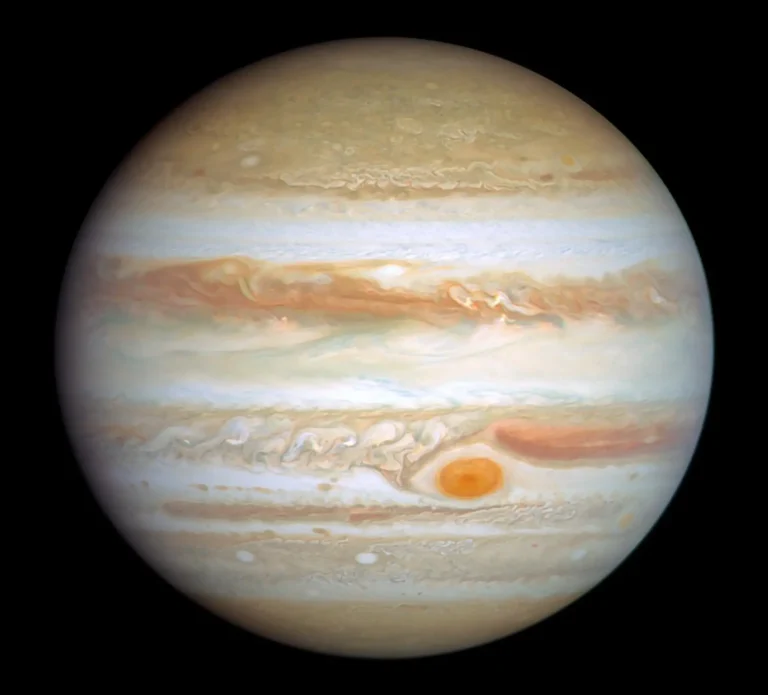Jupiter's Atmosphere
Jupiter, the largest planet in our solar system, has an atmosphere so immense and complex that it dwarfs any other planetary atmosphere. With swirling clouds, powerful storms, and a composition similar to the Sun, Jupiter’s atmosphere offers a glimpse into the early days of our solar system. In this article, we’ll explore what Jupiter’s atmosphere is made of, how it behaves, and answer some of the most common questions people ask about it.

What Is Jupiter's Atmosphere Made Of?
Jupiter’s atmosphere is made up mostly of hydrogen and helium, the two lightest and most abundant elements in the universe. In fact, the composition of Jupiter’s atmosphere is very similar to that of the Sun, which gives scientists valuable clues about how the planet formed.
Main Components of Jupiter's Atmosphere
- Hydrogen (about 90%): This is the most dominant element in Jupiter’s atmosphere. Hydrogen exists mainly in molecular form (H₂) in the upper layers, but deeper down under intense pressure, it becomes metallic hydrogen—a strange, electrically conductive state that doesn’t exist naturally on Earth.
- Helium (around 10%): The second most abundant gas, helium is evenly distributed throughout Jupiter’s upper atmosphere but tends to sink toward the planet’s interior over time due to its weight.
Minor But Important Gases in Jupiter's Atmosphere
Alongside hydrogen and helium, Jupiter’s atmosphere also contains small amounts of other elements and compounds. While they make up only a tiny fraction of the atmosphere, they have a major impact on its appearance and chemistry:
- Methane (CH₄): Methane absorbs red light and contributes to Jupiter’s dark coloration in some areas. It’s especially important for scientists studying the outer atmosphere and its temperature.
- Ammonia (NH₃): Ammonia forms thick clouds high in the atmosphere. These clouds help shape Jupiter’s white and light-colored bands and are a key player in the planet’s dynamic weather systems.
- Water Vapor (H₂O): Deeper in the atmosphere, water vapor exists in high-pressure zones. Water plays an important role in forming thunderstorms and possibly even lightning on Jupiter.
- Hydrogen Sulfide (H₂S): This gas helps form darker clouds in the lower parts of the atmosphere and adds to the planet’s complex chemical makeup.
- Phosphine (PH₃): Found in trace amounts, phosphine rises from deep within the planet. Its presence indicates turbulent mixing and unusual chemistry beneath the cloud layers.
Atmospheric Layers of Jupiter
Jupiter doesn’t have a solid surface, so its “atmosphere” gradually transitions into its fluid-like interior. However, scientists divide the atmosphere into distinct layers based on temperature and pressure:
Jupiter's Troposphere
The lowest layer, where most of Jupiter’s weather occurs. Here, clouds made of ammonia crystals, ammonium hydrosulfide, and water form into bright and dark bands. The famous Great Red Spot—a massive storm larger than Earth—also lies in this layer.
Jupiter's Stratosphere
Above the troposphere lies the stratosphere. It contains complex hydrocarbons formed by sunlight breaking down methane. This layer also contains auroras near the poles caused by Jupiter’s magnetic field interacting with solar particles.
Jupiter's Thermosphere
This upper layer experiences very high temperatures, up to 1,000 K (700°C or 1,300°F), despite being far from the Sun. The heating is mostly due to Jupiter’s magnetic field and the solar wind.
Jupiter's Exosphere
This is the outermost layer, where atmospheric particles drift into space. It is extremely thin and merges with Jupiter’s magnetosphere.
Why Is Jupiter's Atmosphere So Colorful?
Jupiter’s bands and zones come from convection currents and chemical compositions. The lighter zones are made of rising ammonia-rich gas, while the darker belts are regions where cooler material is sinking. The distinct colors—reds, browns, oranges, and whites—result from complex chemical reactions, particularly involving sulfur and phosphorus compounds.
Weather on Jupiter
Weather on Jupiter is extreme and continuous:
- Jet streams move in opposite directions across its bands.
- Storms can form and dissipate quickly, or persist for years.
- Unlike Earth, Jupiter’s storms don’t require a solid surface to form.
The Great Red Spot of Jupiter
Jupiter’s Great Red Spot is an anticyclonic storm that has raged for centuries. It lies in the planet’s southern hemisphere and is about 1.3 times wider than Earth. Winds in the spot can reach up to 432 km/h (268 mph). Although it’s slowly shrinking, it remains one of the most powerful features in Jupiter’s atmosphere.
FAQs About Jupiter’s Atmosphere
Does Jupiter have a breathable atmosphere?
No. Jupiter’s atmosphere lacks oxygen and contains toxic gases like ammonia and hydrogen sulfide, making it completely inhospitable to humans.
How deep is Jupiter’s atmosphere?
The atmosphere gradually thickens as you go deeper. There’s no solid “end point,” but pressure becomes Earth-like at around 100 km (62 miles) below the cloud tops and increases rapidly after that.
Can it rain on Jupiter?
Yes, but not like Earth. Jupiter experiences rains of ammonia or even helium droplets in its deeper layers. Some scientists believe it may even “rain diamonds” deep within, due to high pressure.
What causes Jupiter’s Great Red Spot?
It’s a high-pressure storm system in the troposphere. Its reddish color may be due to chemical reactions involving phosphorus or sulfur compounds exposed to ultraviolet light.
Does Jupiter’s atmosphere have layers like Earth?
Yes, although they differ in composition and behavior. Jupiter has a troposphere, stratosphere, thermosphere, and exosphere, just like Earth—but with completely different dynamics.
Read Similar Articles


